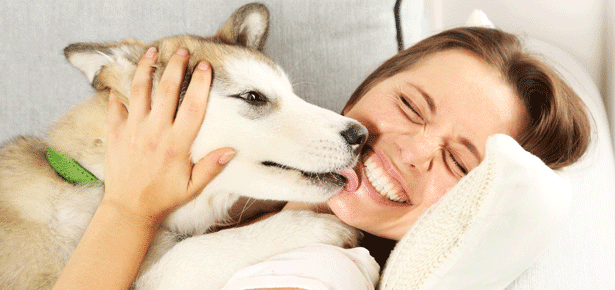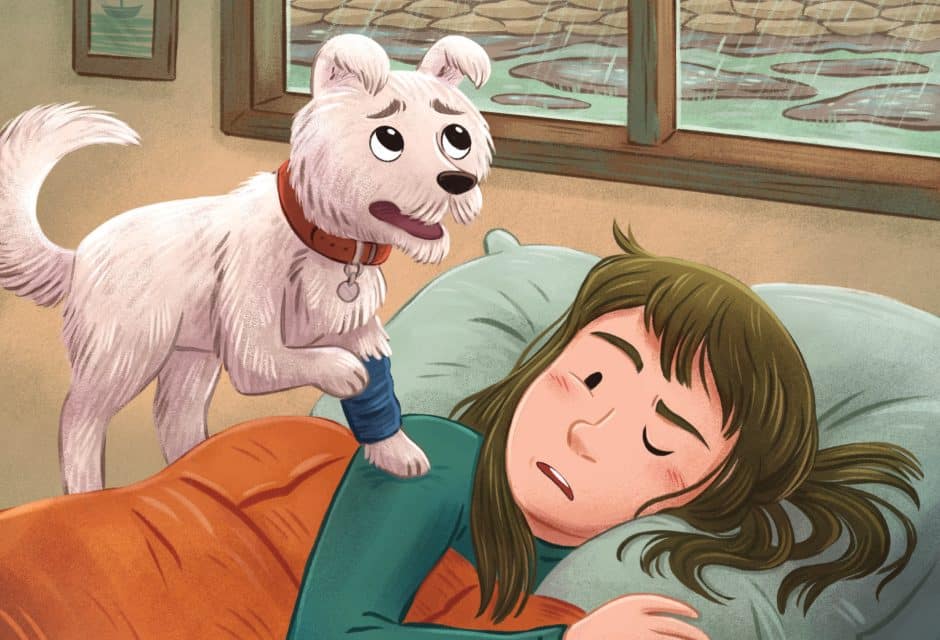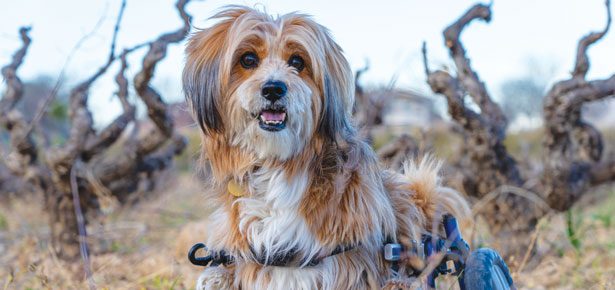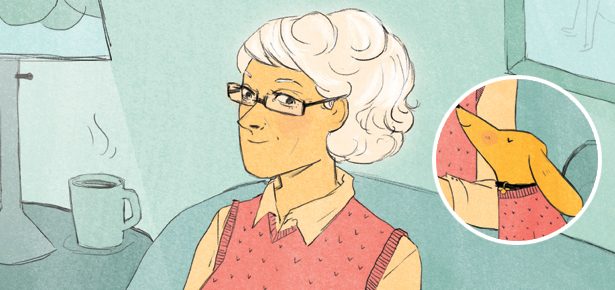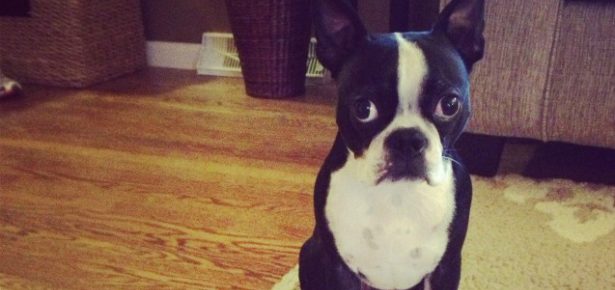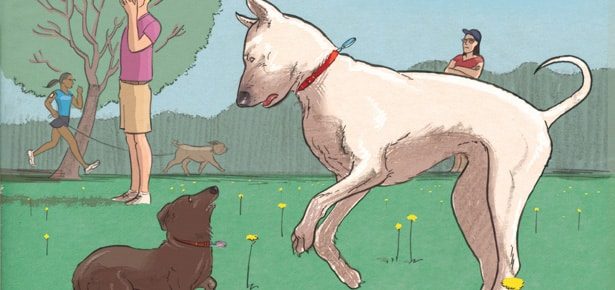
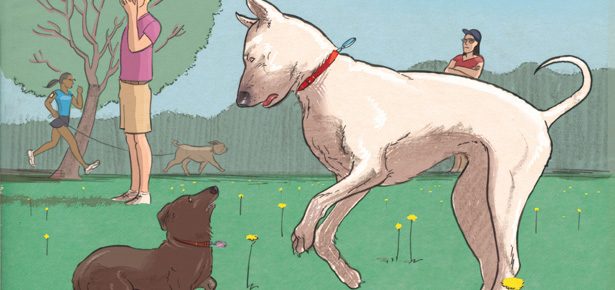
Dog Park Bullies
How to recognize bullying at the dog park and what to do if your dog is targeted
Imagine this scenario: while romping at the local dog park, your dog gets jumped by a four-legged tyrant who won’t play by the rules. Instead of running, chasing, and play-wrestling, the lout pounces on your sweet dog in an overly exuberant and—this is key—clearly unwelcome way. Despite her attempts to get away/ignore him/make nice, she gets pushed around, until she finally snaps and chases the bully off. The bully promptly begins picking on another dog close by. Your good-natured pet has just become the latest victim of a dog park bully.
Anatomy of a Dog Bully: How to Tell if a Dog is Bullying Other Dogs
Dog park bullies aren’t necessarily bad dogs; most simply don’t possess the proper social skills needed to get along with other canines in an off-leash environment. A bullying dog doesn’t usually display overt aggression, but instead acts in an extremely pushy manner, with relentless jumping and nipping or incessant chasing and barking. Unlike well-socialized dogs who know what’s acceptable (and usually have the sense to choose a compatible dog to play rough with), bullies lack this good sense.
Dog park bullies often pick on smaller, shyer animals, those who have less desire to socialize or dogs who seem different in some way. Bullies of breed types with a strong desire to chase or herd will sometimes hone in on dogs who exhibit independent or standoffish behaviour or who appear easy to manipulate. When an offended dog runs away or submits to the bullying, the offender’s conduct gets reinforced, perpetuating the nasty behaviour. In effect, the bully learns to enjoy it.
Bullying behaviour often results when a dog is denied normal socialization as a puppy. While young, dogs learn from littermates and other dogs around them what interactions are permissible and which are rude. If denied this period of social schooling, a dog won’t be prepared to mingle later in life. She won’t necessarily be aggressive, she’ll just be clueless about what other dogs are trying to communicate with body posture, vocalizations, eye contact, or other normal behavioural cues.
A Different Energy: Mismatched Energy Can Trigger Bullying
A well-behaved dog can become a bully when paired with a dog with a different energy level. A rambunctious shepherd mix, for example, accustomed to playing hard with other high-energy dogs, might overwhelm an older, slower pet unused to such frenetic energy. Or, a well-socialized dog, when placed with a more nervous pet, might become antagonistic toward the worrisome dog, whose reluctance to socialize confuses and irritates the more outgoing pet. As is true with human children, a dog who refuses to engage with a more lively animal can often get chased and bullied.
Fearful Dogs: Understanding Defensive Reaction vs Bullying
A dog who suffers from fear-based aggression will almost certainly get into a scrape or two if confronted by more sociable park attendees. This behaviour shouldn’t be confused with bullying; it is instead a defensive reaction to what she thinks is a genuine threat. A fear-aggressive dog won’t go out of her way to chase after or wrestle others; she will simply lash out with little warning, growl and nip, then leave as quickly as possible. Fear aggressive dogs rarely benefit from time at a busy dog park and should not be allowed off-leash around dogs or persons she does not know.
Predatory, Territorial or Possessive Aggression in Dogs
Like fear-aggressive dogs, dogs who display other forms of overt aggression toward friendly dogs are not necessarily lacking in social skills, but instead suffering from more deeply rooted behavioural issues. The dog who runs down smaller dogs with an intent to hurt them, for instance, is not showing bullying, but clear-cut predacious aggression. This dog is not clumsy at socializing; she is trying to hurt others. Likewise, a dog who gets into fights over toys is displaying resource guarding wrath; she loves her ball or wants another dog’s ball. Again, not bullying, per se, but a predictable response from a ball-crazed dog with resource guarding issues.
How to Spot a Dog Park Bully
Dogs have varying levels of tolerance to rough play; one dog’s pal can actually be another dog’s bully. Because of this, you first need to decide on what level of interaction your dog can tolerate before deciding if another dog is bullying yours. If your dog copes well with rough play, hard wrestling, playful nipping, and the like, then it’s probably safe for you to let her work it out herself. If properly socialized, she’ll understand when to let another dog know it has crossed the line and thus take care of it herself.
But if another dog is relentlessly badgering your dog, and your dog can’t cope, consider it a bullying event. When you see another dog chase, jump, nip, bark, and generally be ignorant of any warning cues coming from your dog, assume that bullying is going on.
“Big on little” is often also a sign of overt bullying. Courteous, well-socialized dogs know to be gentler with smaller pets, so if a big goofball shows your petite pal no mercy, that’s a clear indication of bullying. Most little dogs will be more quick to worry about their safety around bigger animals; because of this, the chances of her being bullied are higher than with larger pets. Remember; it’s your dog’s reaction that often helps to define the bullying.
What to Do About Bullies at the Dog Park
You take your dog to a dog park to play, socialize, and burn off some steam, and not to get abused, scared, or hurt. So what is the right action to take if a bully begins to take advantage of your pooch?
If the offending animal appears to be not just pushy but blatantly aggressive, you’ll need to be careful for your own safety while still protective of your own dog. Odds are if the dog is showing true aggression, the dog’s guardian will already be stepping in to deal with the situation. If not, and if the dog seems dangerous, you can clap, yell, throw dirt—whatever you need to do to get the dog off of yours. Once you do, leash up your dog, leave the area, and report the incident to park officials or the police.
Luckily, most bully dogs won’t be aggressive to humans; they just want to push around their own kind. If this is the case, step in decisively while clapping and commandingly telling the abuser to “get!” At the same time, look for the bully dog’s caretaker, who should be nearby. Once the person sees you step in and object to the abusive behaviour, he or she will usually deal with the issue and be apologetic over the dog’s poor behaviour. Even so, it’s likely best for you to find an area of the park away from the bully so your dog can relax. A great way to shut down bullies at the dog park is to bring along other dogs your own dog trusts and likes. Having her own “pack” there will boost her confidence and help in dissuading bullies from stepping in. She’ll have fun, and you’ll be less worried about strange dogs spoiling the moment.
Many dog parks have size-appropriate areas, allowing smaller dogs to mix with others their own size. This ensures that a petite pooch won’t get bowled over or intimidated by the big players, who, even if friendly, could unintentionally hurt a small pet. If your dog is under twenty pounds, consider choosing the “little dog” area where she can play safely.
Is Your Dog a Bully? Yes, it’s possible for your lovable pal to turn into a bully under the right circumstances. If you understand that bullying and aggression are not necessarily the same thing, you’ll see how it is possible for even a gentle dog to become pushy at the park. If she experienced poor litter socialization, early-on dog abuse, or a total lack of training, she could easily be unaware of proper park protocols.
How to Prevent Bullying Behaviour
To minimize the chance of this, teach basic obedience training right from the start, including a reliable off-leash recall command and a “leave-it” command. These two crucial behaviours will allow you to interrupt any dog “fixations” she may form and get her to ignore another dog’s toy. Next, take her on regular “directed” walks with other dogs and people. Directed walks are nononsense leashed walks with minimal play or interaction between pets that more resemble a group “mission” than they do a casual tour of the neighbourhood,. The object is to acclimate your dog to thinking that it’s not always playtime when other dogs are present and that there is sometimes a greater objective at hand. Directed walks will help her learn to become more thoughtful and less reactive to groups of dogs, both in and out of the park. If your dog tends to bully, avoid off-leash activity in favour of leash or extendable lead work. Though she’ll still be able to interact, you’ll be there to instantly shut down any rough stuff as it begins. Once she halts the bad behaviour, get her attention, have her sit, then reward her ability to refocus on you. Gradually allow her more independence with the extendable lead until she gets the idea. Then try off-leash activity again, at first with dogs she knows, then with the general population.
Dog parks are a great way to get your dog the exercise and socialization she needs. But, as there is always one hooligan in the crowd, remain attentive and interactive so you can spot bullies and shut down their shenanigans before they cause your dog undue stress or harm. And when you finally find that perfect dog park filled with sweet doggie angels, stick with it!
Join the newsletter and never miss out on dog content again!
"*" indicates required fields
By clicking the arrow, you agree to our web Terms of Use and Privacy & Cookie Policy. Easy unsubscribe links are provided in every email.

